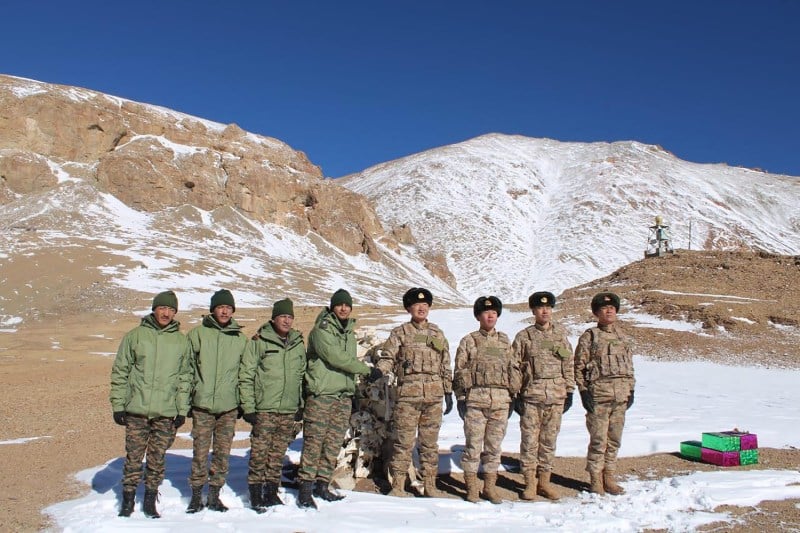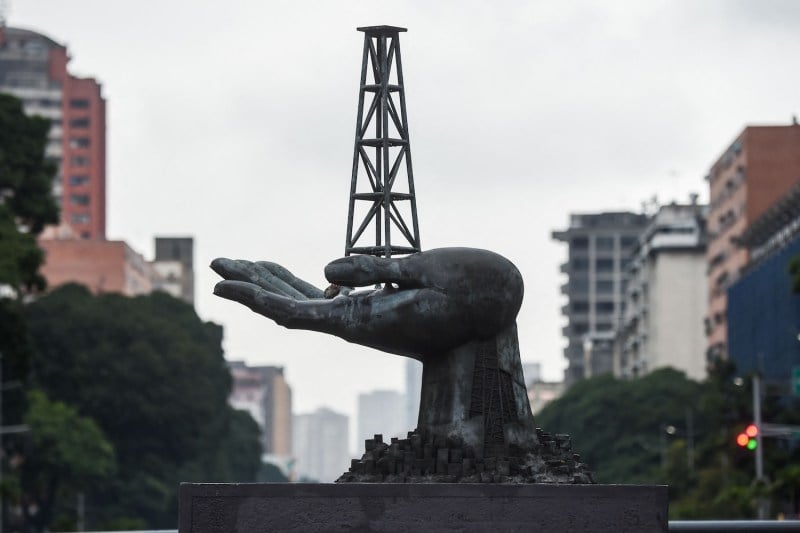China and India Haven’t Patched Things Up on the Border

China and India Haven’t Patched Things Up on the Border
Beijing seeks friendly ties with New Delhi—but only on nonnegotiable terms.
Indian and Chinese soldiers greet one another along the Line of Actual Control near Karakoram Pass in Ladakh on Oct. 31, 2024. Indian Army/AFP via Getty Images
As China and India mark 75 years of diplomatic relations, a moment from history stands out. In 1954, Indian Prime Minister Jawaharlal Nehru and Chinese Premier Zhou Enlai signed the Panchsheel Agreement, a treaty of peace and friendship that promised to usher in an era of cooperation between the two Asian giants.
This optimism was short-lived: In 1962, the Sino-Indian War exposed the deep-seated mistrust and territorial disputes that would come to define the relationship. More than six decades later, India-China ties are beset with the same challenges and haunted by a deadly border clash at Galwan in June 2020. A limited understanding on border patrolling reached last October has not significantly reduced the military presence along their disputed border.
As China and India mark 75 years of diplomatic relations, a moment from history stands out. In 1954, Indian Prime Minister Jawaharlal Nehru and Chinese Premier Zhou Enlai signed the Panchsheel Agreement, a treaty of peace and friendship that promised to usher in an era of cooperation between the two Asian giants.
This optimism was short-lived: In 1962, the Sino-Indian War exposed the deep-seated mistrust and territorial disputes that would come to define the relationship. More than six decades later, India-China ties are beset with the same challenges and haunted by a deadly border clash at Galwan in June 2020. A limited understanding on border patrolling reached last October has not significantly reduced the military presence along their disputed border.
The two countries congratulated each other on their diplomatic anniversary on Monday. In a message to India’s president, Chinese President Xi Jinping said it is right for “China and India to be partners of mutual achievement,” embracing what he called the “dragon-elephant tango.” This sentiment was echoed by Indian Prime Minister Narendra Modi, who said that as two ancient civilizations, India and China should shoulder the responsibility of promoting peace and development. Their overwrought language gave an impression of leaving the bitterness of the last five years behind.
Rapprochement comes with challenges, especially for New Delhi. China seeks friendly ties with India—but only on its own nonnegotiable terms. Meanwhile, India has made concessions in pursuit of normalcy, driven by Modi’s affinity for China, economic and military vulnerabilities, and shifting geopolitics. This cautious approach raises concerns about New Delhi accepting a secondary status in South Asia and allowing Beijing to consolidate its influence.
The thaw in India-China ties since last October has not changed the nature or quantum of the two countries’ military deployment on the border. The announcement of the patrolling deal came hours before Modi and Xi met on the sidelines of the BRICS summit in Kazan, Russia; meetings between special representatives and foreign ministers have followed. India and China are keen to give an impression of friendliness in bilateral ties, despite limited progress.
Surprisingly, India has been more vocal than China in conveying that impression. During a recent podcast appearance, Modi said that after he met with Xi, “we have seen a return to normalcy at the border.” This statement contradicts Indian Army chief Upendra Dwivedi, who characterized the situation as “sensitive but stable,” where a “degree” of standoff still prevails.
Last October, Dwivedi said India is considering restoring the status quo ante—the situation along the border as it was in April 2020. However, Modi said the two countries “are now working in a situation before 2020,” as if that status quo were already restored.
Modi’s comments went beyond the assertion of Chinese Foreign Minister Wang Yi at a press conference last month that a “cooperative pas de deux” was the “right choice for both sides.” Wang added a subtle warning, calling on India not to let border tensions affect overall bilateral ties: “There is every reason for us to support each other rather than undercut each other, work with each other rather than guard against each other,” he said.
The message from Beijing is unmistakable: Beneath China’s friendly façade, its terms are inflexible. At a conference at Fudan University in Shanghai a week after the Modi-Xi meeting, the director of the Chinese Ministry of Foreign Affairs’ Boundary and Ocean Affairs Department—who negotiated the October 2024 arrangement with India—asserted that the consensus “only dealt with disengagement, patrolling patterns and grazing in certain areas.” The Indian side calls it an agreement, a term that China eschews.
Neither New Delhi nor Beijing has made the details of the arrangement public, but reports suggest that India regained access to areas under its control in Ladakh, where its soldiers had been blocked from patrols. However, India also agreed to allow the Chinese People’s Liberation Army (PLA) patrolling rights to the Yangtse area and Subansiri Valley in the Indian state of Arunachal Pradesh, 2,000 miles away.
Dwivedi sidestepped a question on the PLA’s access to these areas in Arunachal Pradesh during his annual press conference in January, giving credence to the idea that India made significant concessions.
At the conference in Shanghai, the Chinese official said Beijing sought a deeper understanding on border issues. The underlying sentiment seemed to be that the fault lies with India. Three decades ago, the two countries agreed to delineate the Line of Actual Control through talks and an exchange of maps. Though India still seeks this clarification, China only wants a permanent border set on its terms, where its claims over Arunachal Pradesh—which Beijing calls Southern Tibet—are the biggest roadblock.
India still insists on the border agreements signed in the 1990s, when the two countries were comparable economic and strategic powers. But a Chinese diplomat dealing with India told me privately in January that these agreements have failed to maintain peace and stability on the border—a fact that India has accepted with its characterization of the crisis—and they should be renegotiated to reflect the reality today. The diplomat said this was one of Beijing’s agenda points for discussions between the two countries’ special representatives last December.
Beijing’s core premise when it comes to the disputed border is that China is now a much bigger military, economic, and scientific power compared with three decades ago. Indian External Affairs Minister S. Jaishankar acknowledged this power disparity in an interview in February 2023. “Look, they [China] are the bigger economy. I mean, what am I going to do? As a smaller economy, I’m going to … go pick a fight with a bigger economy?” he said. “It’s not a question of [being] reactive. It’s a question of having common sense.”
However, China doesn’t recognize that its own constraints play a role in shaping its relationship with India. In fact, a complex array of issues complicates its strategic rapprochement. Internally, Beijing is grappling with economic instability, social discontent, and tensions within the Chinese Communist Party. Externally, China is embroiled in strategic competition with the United States, particularly with U.S. President Donald Trump back in power and promising heightened tariffs and technology restrictions.
These constraints suggest that while rapprochement with India offers mutual benefits, China’s ability to pursue it is limited by its need to address domestic challenges and navigate a hostile geopolitical environment. Under this paradigm, Beijing says all the right things but is practically unconcerned about New Delhi’s sensitivities on strategic issues.
China’s plan to build the world’s largest hydropower dam on the Yarlung Zangbo River, which flows into India as the Brahmaputra River, has raised concerns in New Delhi about potential impacts on water flow and ecological stability. China has deployed a new large phased array radar in Yunnan province with a range of more than 3,000 miles, capable of tracking India’s missile tests. India suspects that China is also building a surveillance post on nearby Myanmar’s Coco Islands.
While visiting PLA units ahead of the Lunar New Year in January, top Chinese generals called for stronger training and combat preparation, citing “military tensions on multiple fronts, the border with India and the Taiwan Strait.”
A China-dominated Indian Ocean would leave New Delhi more vulnerable in any conflict with Beijing. In 2019, the Indian Navy drove a Chinese research ship away from India’s exclusive economic zone near the Andaman and Nicobar Islands after it was detected conducting unauthorized activities. But ships keep coming: In recent weeks, two of China’s most advanced research vessels have conducted sweeps across the eastern Indian Ocean. Such vessels have raised concerns in India over their long stays in the region and their use of equipment to collect data with potential military applications—but it has not changed China’s plans.
On the economic front, China has reportedly restricted the movement of technicians and specialized equipment necessary for high-tech manufacturing, including iPhone production. This move is seen as an attempt to slow India’s emergence as a significant assembling hub, particularly for Apple, by limiting the transfer of critical technologies and expertise.
Meanwhile, India’s imports from China are heading for a record high this year, even as Indian exports to China have contracted, widening the trade deficit between the two countries. Beijing has not taken any substantial steps to redress this trade imbalance, perhaps recognizing that the Modi government has no real leverage to fix the issue.
China’s overtures toward friendly ties on the border come with conditions that India will find difficult to accept, highlighting the enduring challenge of managing a relationship with a more powerful Beijing. China’s reasoning is clear-cut: India lacks the military and economic muscle to counterbalance its might, and attempting to do so could escalate border tensions. Moreover, China is a crucial trading partner, and relying on external alliances to counter it could lead to unforeseen consequences.
For New Delhi, embracing this new dynamic means acknowledging India’s secondary status in South Asia, accepting China’s growing naval dominance in the Indian Ocean, and walking a delicate path to avoid antagonizing its powerful neighbor.
Among experts and analysts, concerns abound that Modi is taking that risky path, particularly because of his personal fascination with China that dates to his time as chief minister of the state of Gujarat. As prime minister, despite numerous border crises, Modi has continued to emphasize the importance of mutual trust and cooperation in guiding India-China relations.
In 2015, Modi described his friendship with Xi as “plus one,” suggesting a level of affinity that went beyond traditional diplomatic relations. But the Indian leader’s efforts to build a personal rapport with his Chinese counterpart have consistently been outmaneuvered. China has asserted its dominance along the border, exploiting Modi’s cautious approach to create a new status quo. Modi seems to fail to effectively read China’s intentions, leaving India vulnerable to coercive tactics.
Trump’s return to the White House and the turmoil created by his early decision-making have aggravated Modi’s troubles. India is navigating a complex web of diplomacy and deterrence, while China extends its economic and strategic influence globally.
At a joint press conference with Modi at the White House in February, Trump offered to mediate between China and India. The U.S. leader’s erratic attitude toward China could either force India into a more hawkish stance or leave it marginalized if Washington and Beijing forge a bilateral agreement. This uncertainty complicates India’s efforts to navigate its relations with China while maintaining its quest for strategic sovereignty and regional influence.
The dissonance is palpable in New Delhi. Though India seems to accept the new border status quo and Modi makes gushing statements about friendly ties with China, Dwivedi maintains that “the two-front threat is a reality,” referring to China and Pakistan. A survey of more than 600 Indians last year revealed the same dichotomy: Nearly half of respondents said greater trade with China is in India’s “developmental and security interest,” and more than half said that “investments from China are beneficial.” At the same time, 41.2 percent of respondents wanted India to strengthen its military posture and deterrence, and 31 percent favored restarting high-level political dialogue between the two sides’ leaders.
By walking on these two parallel tracks, Modi could at best adopt a strategy of cautious accommodation toward an increasingly assertive China. He is biding time and waiting for India’s power to grow before directly confronting Beijing. But this approach involves hoping that China will not escalate tensions in the interim. It also banks on India’s participation in multilateral forums such as the Quadrilateral Security Dialogue and its strategic partnership with the United States. The effectiveness of this indirect balancing strategy remains uncertain.
By kicking the can down the road, New Delhi runs the risk of effectively acquiescing to Beijing’s dominance in the region. Whether India can develop a more robust and comprehensive strategy to address China’s rise or whether it will continue to navigate under China’s shadow remains a pressing question.
But the answer does not lie in India yielding its strategic interests to a pretense of normalcy in bilateral ties with China. The Chinese leadership’s message has been clear: Beijing doesn’t blink. Neither should New Delhi.
Sushant Singh is a lecturer at Yale University and a consulting editor with India’s Caravan magazine. He was previously the deputy editor of the Indian Express and served in the Indian Army for two decades. X: @SushantSin
More from Foreign Policy
-

An illustration shows a golden Cybertruck blasting through a U.S. seal of an eagle holding arrows and laurel. Is America a Kleptocracy?
Here’s how life could change for the rich, poor, and everyone in between.
-

The flag of the United States in New York City on Sept. 18, 2019. America Is Listing in a Gathering Storm
Alarms are clanging at the U.S. geographic military commands around the globe.
-

U.S. President Donald Trump shakes hands with Supreme Court Chief Justice John Roberts during Trump’s inauguration in Washington, D.C. The U.S. Judicial Crisis Is Uniquely Dangerous
But other democracies provide a roadmap for courts to prevail over attacks from the executive branch.
-

An illustration shows a golden Newtons cradle with Elon Musk depicted on the one at left and sending a globe-motif ball swinging at right. Elon Musk’s First Principles
The world’s richest man wants to apply the rules of physics to politics. What could go wrong?










Join the Conversation
Commenting on this and other recent articles is just one benefit of a Foreign Policy subscription.
Already a subscriber?
.
Subscribe
Subscribe
View Comments
Join the Conversation
Join the conversation on this and other recent Foreign Policy articles when you subscribe now.
Subscribe
Subscribe
Not your account?
View Comments
Join the Conversation
Please follow our comment guidelines, stay on topic, and be civil, courteous, and respectful of others’ beliefs.
Change your username |
Log out
Change your username:
CANCEL
Confirm your username to get started.
The default username below has been generated using the first name and last initial on your FP subscriber account. Usernames may be updated at any time and must not contain inappropriate or offensive language.